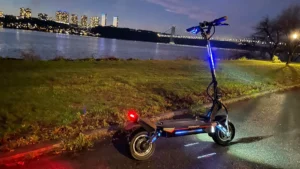As the demand for sustainable and efficient transportation solutions grows, battery-powered scooters, or electric scooties, are evolving rapidly.
Advances in technology are set to make these vehicles even more appealing to consumers. Here are some of the key future trends in battery scooty technology that we can expect to see in the coming years.
1. Improved Battery Technology
Solid-State Batteries: One of the most anticipated advancements is the development of solid-state batteries. These batteries promise higher energy densities, faster charging times, and enhanced safety compared to current lithium-ion batteries. Solid-state batteries could significantly increase the range of electric scooties and reduce charging times to just a few minutes.
Graphene Batteries: Another promising technology is graphene-based batteries. Graphene batteries offer superior conductivity and are lighter than traditional batteries, which could lead to better performance and longer range.
Extended Battery Lifespan: Future battery technologies will also focus on extending the lifespan of batteries, reducing the need for frequent replacements, and lowering long-term costs for consumers.
2. Fast Charging and Battery Swapping
Ultra-Fast Charging: Charging infrastructure is expected to advance, with ultra-fast charging stations becoming more common. These stations could reduce charging times to less than 15 minutes, making it more convenient for users.
Battery Swapping: Battery swapping stations, where users can exchange their depleted batteries for fully charged ones in a matter of minutes, are likely to become more widespread. This technology addresses range anxiety and reduces downtime, making electric scooties more practical for long-distance travel.
3. Enhanced Connectivity and Smart Features
IoT Integration: The Internet of Things (IoT) will play a significant role in the future of electric scooties. Scooties will be equipped with sensors and connected to the internet, allowing for real-time monitoring of battery health, performance, and maintenance needs.
Smartphone Integration: Advanced connectivity features will enable seamless integration with smartphones, allowing users to control various aspects of their scooty through dedicated apps. Features such as remote diagnostics, navigation assistance, theft tracking, and battery management will become standard.
Over-the-Air Updates: Electric scooties will increasingly support over-the-air (OTA) updates, enabling manufacturers to roll out new features, performance enhancements, and security updates without requiring a visit to the service center.
4. Autonomous and Semi-Autonomous Capabilities
Self-Balancing Technology: Future electric scooties may incorporate self-balancing technology, making them safer and easier to ride. This technology can help prevent accidents by automatically stabilizing the scooty.
Autonomous Riding Features: While fully autonomous scooters are still a way off, semi-autonomous features such as automated parking, follow-me modes, and obstacle detection systems are expected to emerge. These features can enhance safety and convenience for riders.
5. Sustainable Manufacturing and Recycling
Eco-Friendly Materials: Manufacturers are focusing on using sustainable and recyclable materials for constructing electric scooties. This includes biodegradable plastics and recycled metals, reducing the overall environmental impact.
Battery Recycling: Efficient battery recycling processes will become crucial as the number of electric vehicles grows. Future technologies will enable better recycling of battery components, reducing waste and reclaiming valuable materials for reuse.
6. Enhanced Performance and Customization
Modular Design: Future electric scooties might feature modular designs, allowing users to customize and upgrade parts such as the battery, motor, and controller. This modular approach can extend the lifespan of the scooty and allow for easy upgrades as technology advances.
High-Performance Models: As technology improves, we can expect more high-performance electric scooties with faster acceleration, higher top speeds, and longer ranges. These models will cater to enthusiasts and those who require more powerful vehicles for their commuting needs.
7. Integration with Renewable Energy
Solar Charging: Some future models might come with integrated solar panels, allowing the scooty to charge its battery using sunlight. This can be especially useful for reducing dependency on grid electricity and making the scooty even more eco-friendly.
Renewable Energy Grid: Electric scooters will increasingly be charged using electricity from renewable sources like solar and wind, further reducing their carbon footprint and contributing to a cleaner environment.
Conclusion
The future of battery scooty technology looks promising, with numerous advancements on the horizon that will enhance range, performance, and user convenience.
From improved battery technologies and faster charging solutions to smart connectivity and sustainable manufacturing, these innovations will make electric scooties more attractive and practical for a wider audience.
As these trends continue to develop, we can expect electric scooties to play a significant role in the transition to greener, more efficient urban transportation.



